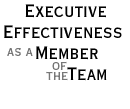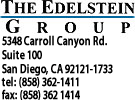



It is axiomatic that senior management's individual and team behavior creates and shapes an organization's culture. Senior executives, individually and collectively as a team, exhibit management behavior that is modeled by subordinates. Over time, executives recreate the organization in their own and the team's image.
Consequently, it is imperative that senior management's behavior is in alignment with the organization's business objectives and reflects the desired culture. Top management must walk its talk. If not, they will torque the organization - telling subordinates to act one way but doing something quite different themselves.
The Edelstein Group's Executive and Team Development Program simultaneously focuses on three key dimensions:
- Executive effectiveness (What executives need to do to increase their effectiveness as leaders of functional areas and enhance their value to the company).
- Executive effectiveness as a member of the team (What executives need to do to increase their value and contribution as members of the team).
- Effectiveness of the team (What the team needs to do to increase its effectiveness).
Business Goals Anchor and Drive the Program
Moreover, the entire program is driven by cross-functional business objectives that have been identified by the team. The business objectives underlying the development process provide a target through which all development efforts are focused. It makes clear how executive and team management behavior must change to ensure individual, team and corporate success. The process is illustrated below.
Executive and Team Development Program
The following illustrates the levels on which the program progresses:
- Executive development as it pertains to leadership and the realization of goals in each executive's respective functional area.
- Executive development as it pertains to clarification of and alignment with the boss's expectations.
- Executive development as it pertains to effective participation as a member of the executive team and cooperating across functions to ensure the realization of business goals.
- Team Development as it pertains to the team's effective leadership of the company.
Dimension I |
Dimension II |
Dimension III |
|
Activity |
Review workplace feedback pertaining to each executive. |
Boss and subordinate review workplace feedback with one another. |
Review workplace feedback pertaining to the executive, executive's team behavior and the team itself. |
Outcome |
Management behavior in alignment with and driving business goals. |
Subordinate and boss know how to support one another. |
Team behavior and team norms drive accomplishment of business goals. |
The Executive and Team Development Program incorporates the following key features:
Individual Executive Development
- Eight, one-to-one coaching meetings.
- 360º workplace survey and 16PF to identify strengths and weakness of management behavior.
- Review of 360º survey results to identify main messages.
- Formulation of Development Plan and subsequent one-to-one meetings to determine whether plan is having the desired effect.
- Meeting with boss to review workplace feedback and ensure alignment with expectations.
Team Development
- Share 360º workplace feedback with team members to increase understanding of each other's strengths and weaknesses as executives and how best to complement one another.
- Share 360º workplace feedback with the team as it pertains to how the organization views the team's strengths and weaknesses.
- Identification of metrics through which individual executive and team Development Plans are focused and progress is measured.
- Identification and tracking of dimensions of team effectiveness necessary to realize strategic goals.
- Identification of a project that will enable the team to practice desired mode of operation and team behavior.
- Utilization of Playing Field/Practice Field Technique to conduct real-time analysis of team's functioning.
The executives' Management Factors Survey profiles are combined to form a composite picture of the team's management strengths and weaknesses including direct feedback pertaining to the team's performance. The narrative comments are summarized and provide a vivid picture of the team's management behavior. Since each EXCEL participant has distributed approximately 25 assessment forms, and since there are usually at least 6 executives comprising the senior management team, the composite picture is derived from a fairly broad sample and is representative of how the company views the team.
As the team comes together to review the composite data they typically use it to:
- Identify team management strengths and weaknesses.
Example: Are we abstract thinkers who put together great strategies but don't execute because we don't effectively communicate our ideas to others?
- Identify positive and negative attributes of the corporate culture and determine whether they are appropriate for the company's stage of development
and business environment.
Example: Do we treat people respectfully but at the same time not hold them accountable for results? Do we talk cooperation across functions yet ourselves engage in internecine warfare?
- Make commitments about how management behavior needs to change at the top in order to set the right tone and example for the rest of the company.
Example: Do company norms support constructive conflict or are strongly held opinions kept in check in order to preserve harmony? And, do we hold people accountable to the same standards and results, or do we let people off the hook?
The Executive and Team Development Program increases cohesion and modifies corporate culture and management behavior. Surfacing critical cultural determinants and management behaviors enables the team to determine what needs to change in order to lead the company in a new direction and improve performance.
Home | Consulting Programs | About Us | Principals of the Firm | Locate & Contact Us | Pre-employment Assessment | Individual Executive Development | Executive & Team Development